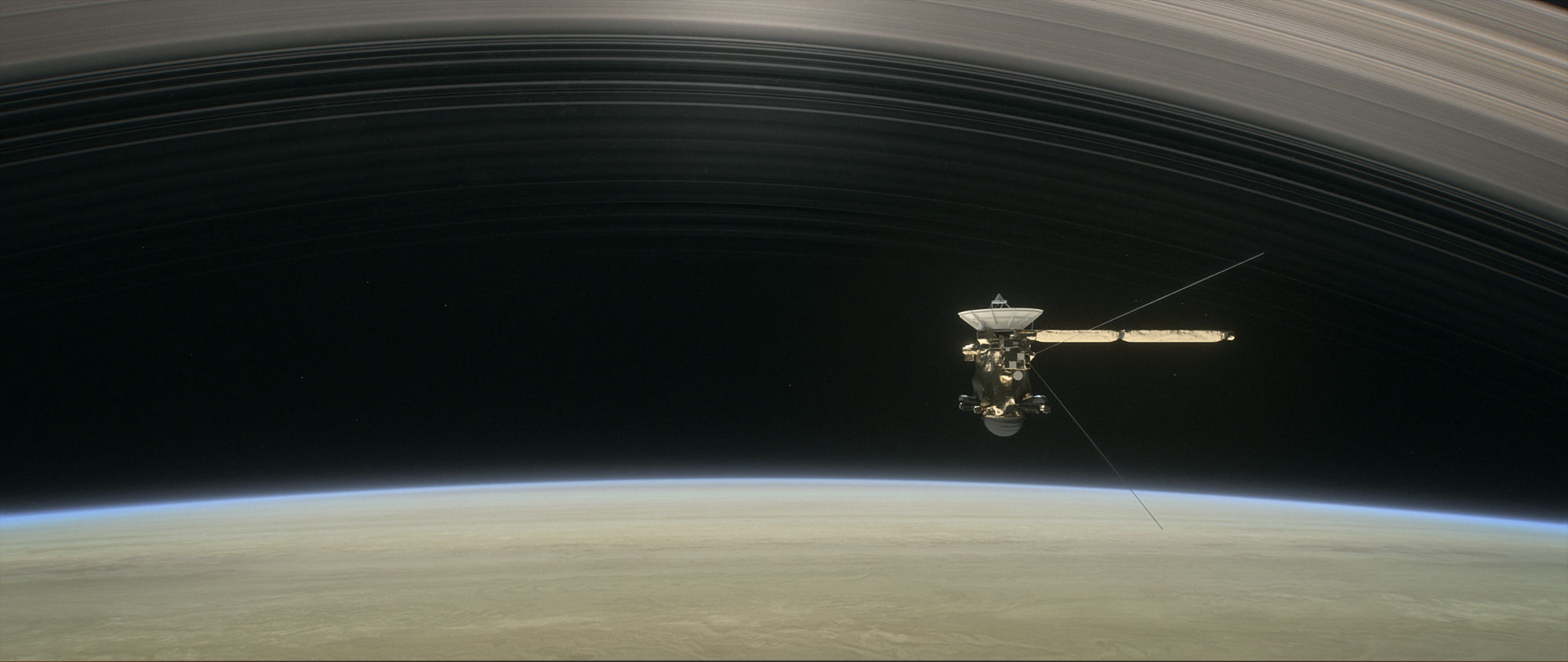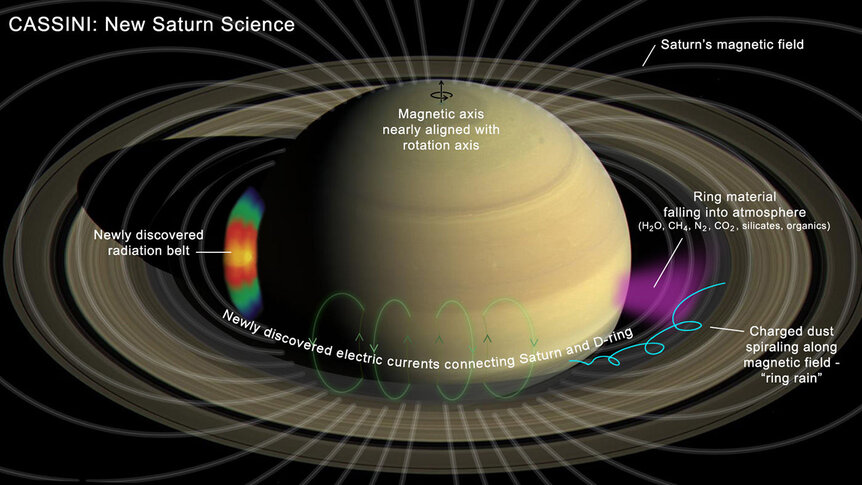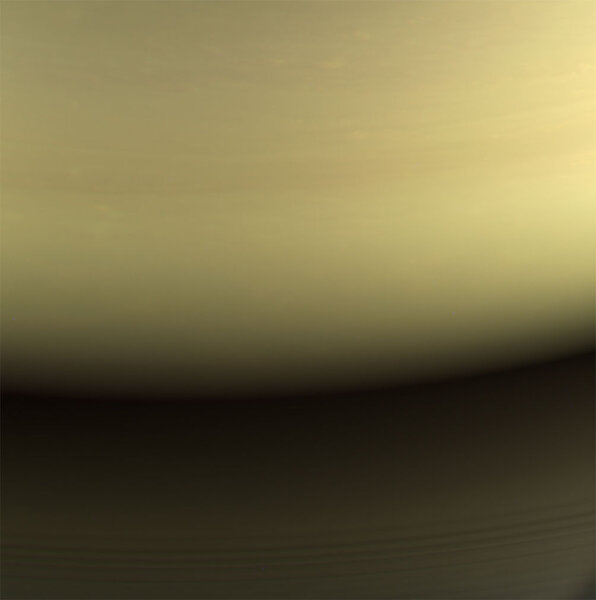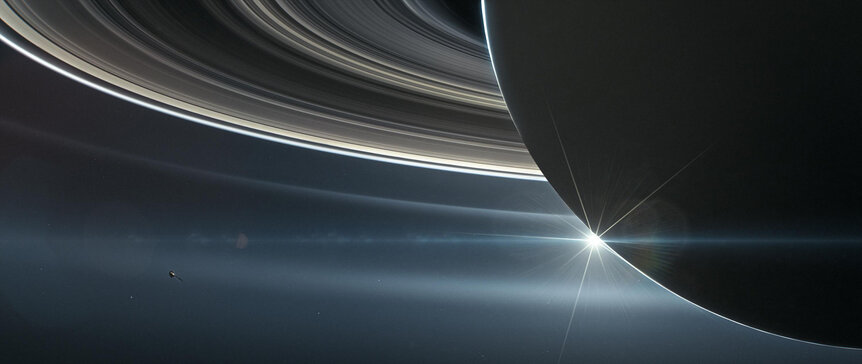Create a free profile to get unlimited access to exclusive videos, sweepstakes, and more!
Cassini gives us more Saturn from beyond the veil

One year ago last month — on September 15, 2017 — the Cassini space probe plunged into Saturn’s atmosphere at over 111,000 kilometers per hour. Like a meteor, the immense pressure it generated as it rammed through the alien air heated it to incandescence, and what parts of it didn’t vaporize dropped down into the stygian darkness of the planet, crushed by weight of the gases above it.
On that day, the mission ended. But not the science.
Over the last five or so months of the mission, Cassini —using the gravity of the huge moon Titan for an assist — followed a series of looping orbits, taking it as far as 1.6 million kilometers from Saturn to a razor’s keen edge of just 1,600 kilometers above the cloud tops. In the last five orbits it actually passed through Saturn’s upper atmosphere, allowing the spacecraft to wring some final measurements and observations even as the end inevitably approached.
And now, after the Earth has gone ‘round the Sun once since, scientists have announced what they learned from Cassini last gasps.
Rain of Ice and Dust
Saturn’s graceful and broad rings look separate from the planet, but that isn’t really the case. A flurry of ice from the inner rings is falling down into the atmosphere of Saturn, ranging from roughly 5 to 45 tons of material impacting Saturn per second.
That may sound like a lot, but remember that Saturn is vast, well over 100,000 kilometers across. When spread out that much, this is a thin precipitation.
Much of the ice is water ice, which is expected. The rings are almost entirely made of water ice. However, there was also an unexpectedly high amount of heavier material as well, including methane and ammonia, as well as complex carbon-based molecules, what chemists called organic molecules. It’s known that some of these come from the moons Enceladus and Titan, but some of the organics detected don’t match those from either moon. That means a third source, as yet unknown, is also feeding material into the rings.
They also found that the amount of material falling in changed considerably over the several orbits Cassini made, which means the flow isn’t steady. That in turn implies something stirred up the inner rings (the D and C rings) recently. Very recently: The structure of the D ring could be explained by the breakup of a comet by Saturn’s fierce gravity in the 1980s.
This makes sense in another way, too. The rate at which matter is falling into Saturn would deplete the D ring in a few tens of thousands of years. So either we are really lucky to see it now (given that Saturn is billions of years old), or the amount falling is much much higher than usual. If a comet came in and bulled around in the D ring china shop, then that would increase the icefall.
Cassini instruments also detected fine grains of dust falling down from the rings. And by fine, I mean fine: Much of it in the form of grains just a few tens of nanometers in size. A typical human hair is 10,000 times wider.
Grains this small can be electrically charged through various methods (like how a balloon rubbed against your hair can get a static charge) and that can dominate how they behave, even more than Saturn’s gravity. These charged grains follow Saturn’s magnetic field, falling down into the atmosphere pretty quickly, taking just four hours or so to get from the inner rings to the top of the atmosphere. Several tons of these fine-grained particles are created across the rings every second, and it’s unclear what process is doing this. Only a fraction of the total makes its way down to the planet.
Interestingly, that production rate implies the rings would be ground down to very fine particles in less than half a billion years, in turn implying the rings are either young or being replenished. This is an ongoing mystery, perhaps the biggest about the rings.
Proton Belt
Saturn has a strong magnetic field, which can influence the motion of charged particles around the planet (much like Earth’s magnetic field channels them down into our atmosphere, creating aurorae). This creates a belt of charged particles around the planet, like our van Allen Belts. In general, the rings are so dense that particles from far out in Saturn’s magnetosphere can’t make it down to the planet. They get blocked.
But an isolated inner belt has been proposed, implied by earlier measurements from Cassini. The last few orbits took Cassini right through this region, and it turns out the belt is indeed there. One of Cassini’s detectors sensed a population of high-energy protons occupying the space from the top of the atmosphere up to about 75,000 kilometers above, limited at the bottom by the atmosphere and the top by the tenuous D ring.
Where do these protons come from? Interstellar space! Kind of. They start off as high-energy cosmic rays, which are atomic nuclei accelerated to ridiculously high speeds in supernovae. They zip across the galaxy, including through our solar system. If one of these hits a bit of ice in Saturn’s rings it can create a free neutron. This neutron can then decay into a proton, an electron, and an antineutrino. This process is known to supply protons in Earth’s magnetic field, but it wasn’t clear if it could be enough to do this for Saturn’s inner belt.
Apparently it is, since that’s what was seen in the thin gap between the planet and the inner rings. This can affect the structure and composition of both the atmosphere there and the rings.
A Swiftly Non-tilted Planet
Another weird thing Cassini determined is that Saturn’s magnetic field is almost perfectly aligned with its spin axis. That’s not the case at all with Earth and most other planets.
Think of it this way: The Earth is spinning like a top, so we have a north and south spin pole, what are usually just called the poles. We also have a magnetic field that’s like a bar magnet. But that field is tilted with respect to the Earth’s spin by about 10° (and it wanders around, too). On Saturn, that tilt is only 0.01°!
Planetary magnetic fields are generated by a dynamo effect: Deep inside the planet is an ionized material (very hot liquid iron in Earth, highly compressed metallic hydrogen in Saturn). As the planet spins a current is generated in the liquid, and when you spin up an ionized material you generate a magnetic field.
In general you get an inclination to the magnetic field, but Saturn’s field being almost perfectly aligned with its spin indicates, ironically, something more complicated is happened deep below the surface, likely having to do with the way the material is flowing. It also may be due to two separate layers around Saturn’s core generating the magnetism.
These results (and others also released) may seem a bit esoteric. Perhaps they are. But they are all pieces to the puzzle of Saturn: What makes it tick, why it is the way it is, how it behaves, how all its complex systems interact, and how all this changes over time. There are still grand mysteries to solve about this giant planet — it’s a big place, and Cassini, as amazing as it was, was only one spacecraft that orbited for 13 years; less than a billionth of Saturn’s existence. Not even the tick of the cosmic clock. So there’s still a vast amount left to learn, and every time we do learn something, no matter how small that datum may seem, it’s another gap filled in.
We learned a lot over those years, though, and as the mission went on scientists and engineers learned about the spacecraft, too, and what it could do. That’s why the risks near the end paid off. This knowledge was made possible because of Cassini’s last daring moments.
On that last day, Cassini burned up about 400 kilometers above the planet’s cloud tops — on a planet 110,000 kilometers in diameter.
We have literally only scratched Saturn’s surface.

















